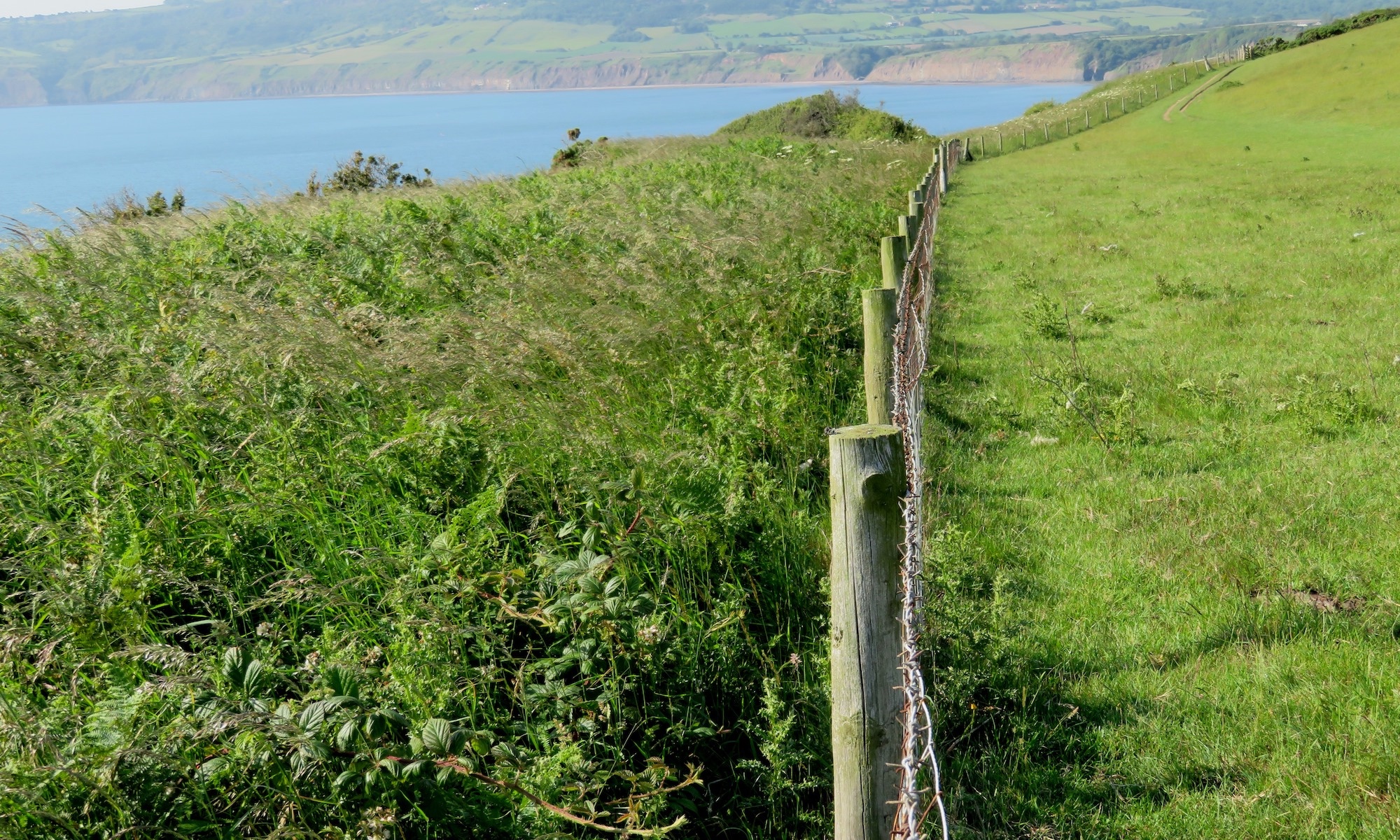by Georgina Valentine
19th July, 2022
I attended this year’s ‘Walk For Wilding’, an 11 mile sponsored walk organised by Scotland The Big Picture, at the end of May. It was a fabulous day, very informative and hugely inspiring. My 87-year-old dad had been talking about ‘Glen Affric’ and ‘Trees for Life’ for some years but had never managed to visit this rather remote part of the Highlands to see it for himself. So when I saw the advert for this event I thought it would be a wonderful opportunity for Dad and myself to experience this for ourselves, as well as helping to raise funds for STBP. As you can imagine we were a little intrepid about whether we would actually manage the 11 miles but were willing to give it a go when we saw that the route would be ‘fairly flat’, round the edge of Loch Affric. As a newcomer to the rewilding movement this was a great opportunity for me to meet others and learn more.
Glen Affric is part of Affric Highlands, a landscape scale rewilding / nature recovery project engaging landowners and stakeholders in helping facilitate the recovery of a more healthy ecosystem and greater biodiversity, as well as community engagement and the development of nature-based enterprises. Much of the Highlands, like a lot of Scotland, is degraded land, devoid of trees and lacking biodiversity due to high deer numbers, sheep farming and grouse estates. Loch Affric is south of Inverness, in one of the valleys on the west side of Loch Ness an area which has high rainfall, a post-glacial mountainous terrain and remnants of ancient pine forest. It is sometimes referred to as ‘Scotland’s Rainforest’. More information can be found here: https://rewildingeurope.com/areas/affric-highlands/
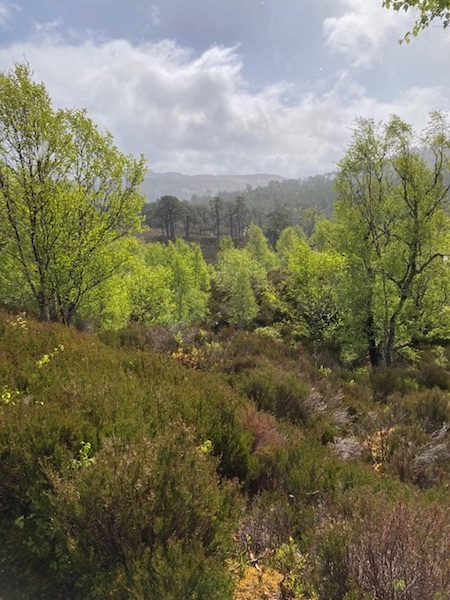
The weather was kind and nine intrepid explorers met at our meeting point – the car park at Loch Affric – itself a 10 mile drive from Cannich, the nearest village. People had come from Inverness, Aviemore, Edinburgh, Dundee… and one woman was on the final day of her visit to Scotland, from her home country, Israel.
Our day started with a warm welcome and introductions by our two guides, Dan Puplett (Ecologist) and Linzi Seivwright (Deer Management Specialist). Dan showed us a relief map of the area so we could get a feeling for the scale of the project and the geological forces which have shaped this part of Scotland, with its abundance of rivers, lochs and steep mountain valleys which lie in a predominantly East/West direction.
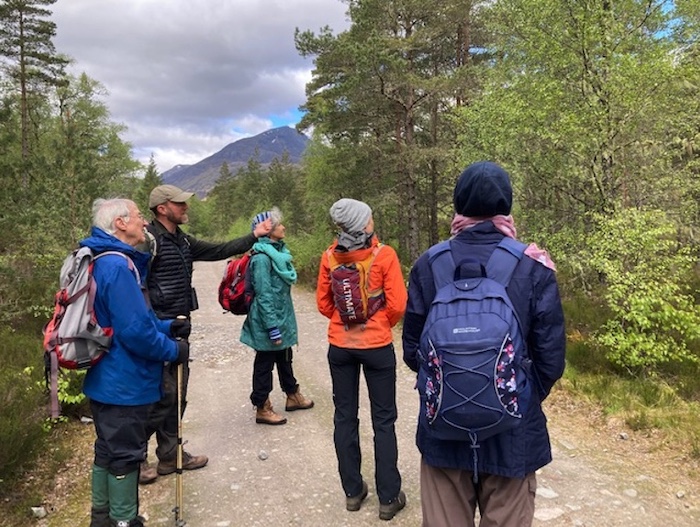
The location is absolutely stunning, even from the car park we were surrounded by graceful birch trees, their pale spring leaves fluttering gracefully in the breeze, while cheeky chaffinches danced around our feet and dared to eat sunflower seeds from our hands. The absence of the usual noise created by human activity is something that one can only attempt to describe as it permeates deeply into one’s being.
We set off along the south side of the loch along a track heading towards Athnamulloch Bothy which is at the far end of the loch. As we walked, the expertise of our guides brought what we were seeing to life and put it in context.
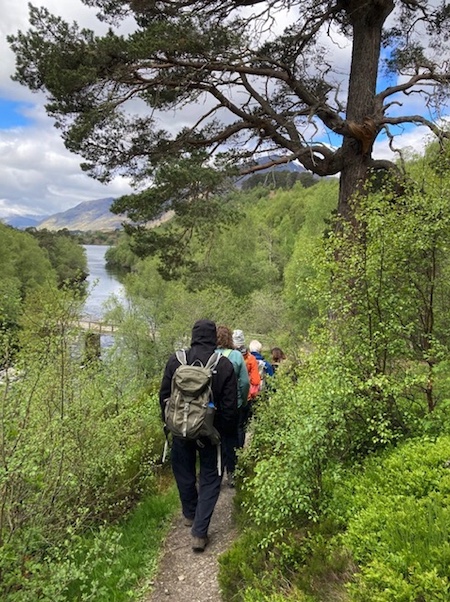
One of the key interventions in this project has been installing deer fencing to exclude deer and allow natural regeneration of the pre-existing forest.
Here are some of the issues we saw and discussed during the day:
- The importance of community / stakeholder involvement and collaboration.
- The complexity of approaches to reducing deer numbers – installing fencing is expensive and labour intensive and creates an ‘artificial barrier’ which later has to be removed.
- Deer are part of the ecosystem and are never entirely eliminated even within fenced areas (snow levels in winter sometimes enable them to breach fences).
- Aerial photographs are used to map and count deer numbers. They are monitored regularly. Linzi showed us an amazing map which looked like an OS map with coloured squares representing deer densities.
- Deer culling needs to be regulated for humanitarian reasons.
- Where stags overwinter at the bottom of the valley no trees will regenerate and the river banks are therefore suffering erosion. (During the rest of the year deer prefer to live higher up the mountains away from human activity).
- The removal of ‘non-native’ species requires a careful weighing up of factors. We saw an area of a German variety of the Scots Pine tree, very tall and straight (without the iconic ‘umbrella’ shape canopy that Scots Pine often exhibit). As these are well established and creating an eco-system of their own they have been left to grow. Removing them would possibly cause more damage and in the light of climate change they may prove more resilient.
To my surprise we saw deer hoof prints in the mud while in a fenced area, however we also observed young seedlings growing unbrowsed (Aspen is a particular favourite of deer) and our guides concluded that the deer numbers must be low enough to be negligible in impact. They also pointed out that deer understandably don’t linger in areas along roadsides (even in this remote location there were a number of cyclists and hikers).
We walked and walked and walked… and finally the bothy, our stopping point for lunch came into view. Athnamulloch Bothy is situated at the top of the valley, in its basin, next to the river. This area has not been fenced and the contrast is stark – the land is bare, nibbled to the bone by deer. The view however of the hillside opposite could not be more inspiring. The pioneering birch trees have really taken hold and are now tall enough and well established enough that the deer fence has been removed. A whole woodland now cloaks the side of the mountain, reaching high up the slopes in its natural unregulated glory. The mountains with their clothes on look so much happier.
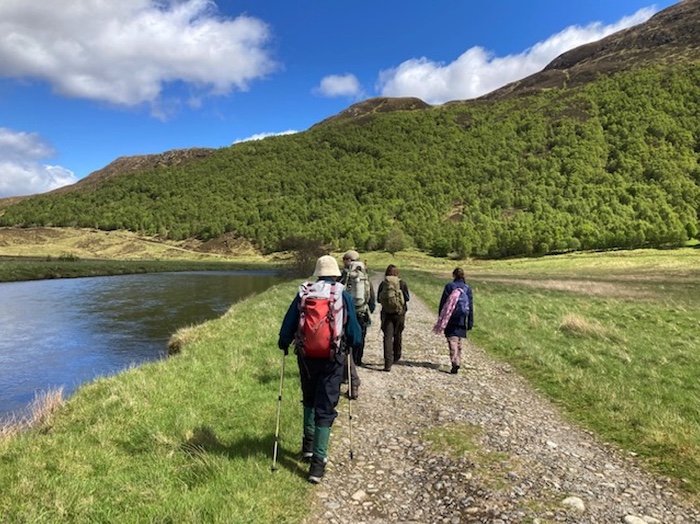
Quiet descended as we ate our sandwiches and after the welcome break we headed back, pausing to examine and wonder over so many amazing species… a buzzard flying overhead (no golden eagles this time) a sexton beetle with its bright orange markings on the path, wonderful boggy areas of sphagnum moss, the smell of pine needles crushed between the fingers (a brew up of pine needles when I got home was surprisingly pleasant) and so much more.
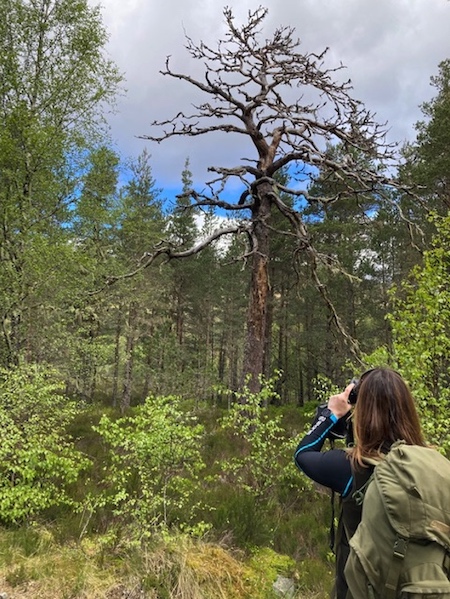
The final slope up to the car park was achieved and thanks to the generosity of our guides we enjoyed tea, cake and continued conversation in the sunshine at the end of what was a truly inspiring and uplifting day.
Personal highlights:
- Being immersed in a breathtakingly beautiful and species rich environment
- Being with like-minded people and learning so much from the generous expertise of two professionals
- Hearing a willow warbler – the song is described as a ballerina pirouetting or a leaf falling downwards
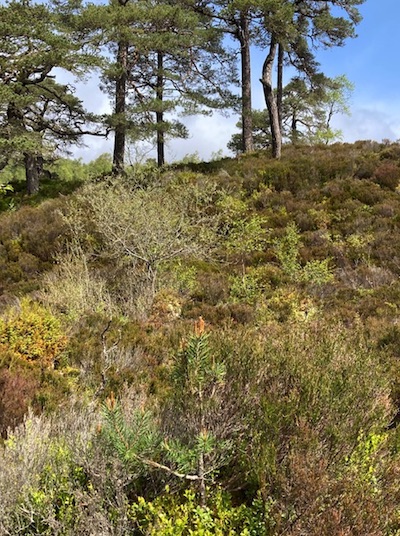
- Seeing healthy Scots Pine seedlings bursting up through the heather (the cones disperse with the help of wind and squirrels, they don’t usually do well directly under the canopy of the parent tree)
- Seeing well established woodland dispersing naturally up the hillsides – no straight lines!
- Having lunch in the sunshine outside the bothy
- Walking my socks off!
